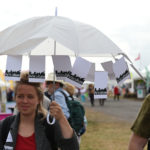rosiestrang
Forum Replies Created
-
AuthorPosts
-
 rosiestrangParticipant
rosiestrangParticipantJourney to the end of the night – London 2007.
Journey to the end of the night is a city wide street game. Competitors race by foot around an urban area with a visible colored ribbon. Along the way, groups of chasers attempt to tag them, and if they are successful, they remove the competitor’s ribbon. Competitors can also seek refuge in designated safe zones. The first competitor to get to all designated checkpoints in order wins.
https://en.wikipedia.org/wiki/Journey_to_the_End_of_the_Night_(game)
The version that I took part in that ran in London in 2007 was created by a theatrical company called Gideon Reeling, who brought the game alive with chasers in character, bizarre and intriguing encounters such as meeting in the industrial landscape of east London, gatecrashing a party in bar basement off Tottenham Court Road, and rendevousing with spys by the Serpentine Lake.
https://gideonreeling.co.uk/work/this-is-it?category=all
Key in audience interaction – dramaturgy, scenography or technical mechanisms
The dramaturgy puts the audience at the centre of the story – its their epic journey to get to the end of the night ‘alive’. Once ribboned up they have signed up to complete the ‘challenge’ – there is no turning back – just forward – chased by chasers who are released in a surprise attack from an industrial lorry at the start of the game in the industrial wasteland carpark – into the unknown night.
The bizarre and intriguing checkpoints that need to be visited to complete the journey, with strange characters, locations and stories deepens the sense of stepping into the unknown and potential ‘dangers’. They served to heighten even further the imaginations of the audience taking part – suddenly everyone you encounter in this bustling city has a story, every situation is studied much closer and with a different perspective as it could be a possible threat – the whole city and its inhabitents comes alive to play a part in the game/experience.
The rules of engagement and movement around and through the city changes dramatically – we found ourselves negotiating our way through the back storage of indian restaurants on Brick Lane at one point – recruiting the staff working to help us in our mission.
 rosiestrangParticipant
rosiestrangParticipantTwo places I would define as public spaces –
1. The high street of the town I live in. 2. The beach near my town.What makes them defined as public spaces –
*Open and accessible to people – to some extent ‘managed’ and maintained
*A social space for potentially everyone in the society to participate in and express themselves, engaging with their community in different ways – business, culture, recreation etc.
*Inclusive and reflective of the diversity of people living the in area
*Form the stage and backdrop to the ‘drama’ of life – rituals, gatherings, rhythms – day to day and season to season.
*Reflects the local culture, history and landscape – and integral to wider ‘biosphere’ of all living things.
*No personal privacyA definition of public space could be –
A social space for the potential for everyone in society to participate in and express themselves through rituals, gatherings, and rhythms, that reflects and connects local life – economy, agriculture, education, culture, history, and wider natural landscape of all living things.Interesting to reflect on this during an international pandemic!
 rosiestrangParticipant
rosiestrangParticipantHello, Rosie here from Articulture, working with Annie G (see below) and others. We support the development of innovative, high quality outdoor arts and diverse engaged audiences in Wales.
The movement of pervasive or alternative reality gaming in recent years completely inspired me – the powerful way it draws creatives and participants from all corners of communities to re-imagine their public spaces and how we interact.
In the words of leading game designer Jane McGonigal games challenge players to tackle real-world problems at a planetary-scale: hunger, poverty, climate change, or global peace. Others are simply designed to make players happier in their everyday lives — by dancing more, say, or by being kind to strangers. And some have specific positive health impacts in mind – increasing physical activity.
Playing her game Cruel 2 B Kind and others at the UK’s first pervasive gaming festival in the heart of London in 2008 across the whole of the Southbank with 250 other people changed forever the way I experienced and interacted with others in public space – it opened up a whole new world of possibilities. Cruel 2 B Kind is game of benevolent assassination where your secret weapon is a random act of kindness. As assassins team up scenes such as groups of 50+ people kneeling and saying ‘I really love your shoes!’ to 75+ other people running away across Hungerford Bridge saying ‘I would love to buy your flowers!’ was beautiful, bewildering, and life changing. And withnessing all the envitable acts of kindness that get made to random members of the public in the process – resulting in a collective glow of love and appreciation across the whole of the Southbank.
Closer to home one of my favourite Articulture commissions with the Wales Outdoor Arts Consortium was ‘Electioneering’ by Mr & Mrs Clark. Through street performance they explore the body postures, facial expressions and hand gestures of those promising to hand back control and make their countries great, again. It culminates in members of the public being roped into to a ‘general election’. Vital work in the UK where political discourse is often distorted and divisive – its total timeless gold.
-
AuthorPosts

